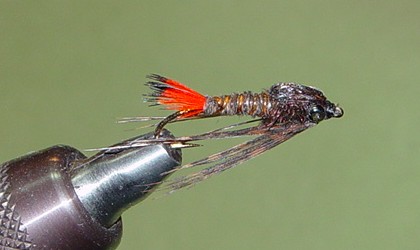
On The Fly
"Fly tying is a school from which we never graduate"
TYING NEWS
Our friend and colleague Johnny Hale passed away at Fish
Lake on June 2nd. He was an exceptional man and a good friend. Our thoughts
and prayers go out to his wife, Judy, and the family. He will be missed by
all in so many ways. We will especially miss his generosity of time and
knowledge, his dedication to teaching, his influence on future fly tiers,
and his friendship to us that knew him. His legacy lives on through us and
the best way to honor Johnny is to build skills on his influence and pass
the art along to future generations.
The Southern Oregon Fly Tiers met Tuesday, June 12th, at
the Madrone Hill community building near Gold Hill. Much of our time
together was spent remembering the great times at past meetings with
Johnny. This location is going to work out great for our club meetings each
month. There is plenty of room for more tiers. We encourage novice and
experienced tiers alike to drop by the second Tuesday of each month for a
fun evening. The next meeting will be on Tuesday, July 10.
 PATTERN OF THE MONTH - Johnny O
PATTERN OF THE MONTH - Johnny O
Hook: Tiemco 200R or equivalent.
Thread: 8/0 black.
Eyes: Dark brown glass beads, barbell style on mono.
Tag & rib: Small Liquid Lace or Larva Lace, light brown.
Tail: Hot orange hackle fibers.
Body: Pheasant tail fibers.
Thorax: Brown ostrich.
Wing case: Pheasant tail fibers.
Legs: Pheasant rump hackle.
Tying Instructions:
1) Start the thread one eye length behind the eye. Tie on the eyes using
the figure-eight method. Wind a thread base back to just above the barb of
the hook.
2) Tie in the Larva Lace and wind it forward to a point just above the
point of the hook. Tie off but donít trim because the Larva Lace will also
serve as our rib.
3) Tie in a clump of hot orange hackle fibers up against the tag so the
fibers cock up. The tail should reach to the bend of the hook.
4) Tie in several pheasant tail fibers, twist them into the thread and wind
forward about 2/3 shank length. Do not trim off the butt ends, they will be
used for the wing case.
5) Tie in four ostrich fibers, twist them into the thread and wind forward
to the back of the eyes to form a fuzzy thorax.
6) Wind the rib forward in equally-spaced turns over the body and thorax,
and tie off.
7) Select a pheasant rump hackle feather with barb long enough to reach the
hook length. Tie it in by the tip and wind it forward two turns. Tie off.
8) Separate the hackle fibers at the top of the hook, putting equal amount
on both sides, and then pull the pheasant tail fibers (from Step 4) over
the thorax and hackle to form the wing case. Tie off in front of the eyes
and trim.
9) Form a neat thread head, whip-finish and apply head cement.
The Johnny O was developed by Johnny Hale and fittingly
named by his friends on his last fishing trip. The pattern evolved from a
lifetime of tinkering and experimenting at the tying desk. Those of us who
knew Johnny, or watched him tie, or took his classes, could count on the
fact that he hardly ever tied the exact same fly more than twice. Thatís
what makes this pattern so unusual. Over the past four months he tied
dozens the same, varying only the color of materials and size. I had never
seen him so enthused about a pattern before. He truly believed it had the
best qualities of a great nymph and it worked. On his first trial it caught
trout. Itís a good reminder to all of us: use materials that are proven
attractors, make it buggy, get it down in front of the fish, and fish the
fly with confidence. So tie some up, give them a test flight, and let me
know how you did.
TYING TIPS
Like Johnny, you can vary the colors, size, and even
materials used. Be creative; donít get lulled into using exact copies of
what you see in a book. Once you learn the concept of a pattern or
technique use the materials and colors you have on hand. Who knows, you may
come up with the next miracle pattern.
Tie One On,
Dan Kellogg (you can contact me at FLYGUY@EZNORTHWEST.COM)